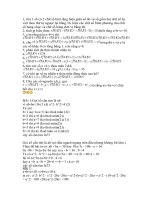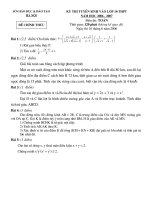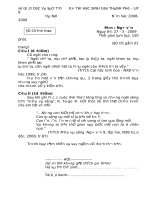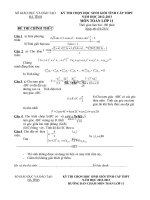Đề thi Toán học Hà Nội mở rộng HOMC năm 2015
Bạn đang xem bản rút gọn của tài liệu. Xem và tải ngay bản đầy đủ của tài liệu tại đây (128.78 KB, 6 trang )
<span class='text_page_counter'>(1)</span><div class='page_container' data-page=1>
Hanoi Open Mathematical Competition 2015
Senior Section
Important:
Answer to all 15 questions.
Write your answers on the answer sheets provided.
For the multiple choice questions, stick only the letters (A, B, C, D or E) of your
choice.
No calculator is allowed.
Question 1. The sum of all even positive intergers less than 100 those are not
divisible by 3 is
(A): 938; (B): 940; (C): 1634; (D): 1638; (E): None of the above.
Answer: C.
Question 2. A regular hexagon and an equilateral triangle have equal perimeter.
If the area of the triangle is 4√3 square units, the area of the hexagon is
(A): 5√3; (B): 6√3; (C): 7√3; (D): 8√3; (E): None of the above.
Answer: B.
Question 3. Suppose that a > b > c >1. One of solutions of the equation
(x−a)(x−b)
(c−a)(c−b) +
(x−b)(x−c)
(a−b)(a−c) +
(x−c)(x−a)
(b−c)(b−a) =x
is
(A): -1; (B): -2; (C): 0; (D): 1; (E): None of the above.
Answer: D.
Question 4. Let a, b, c and m (0≤m ≤26) be integers such that
a+b+c= (a−b)(b−c)(c−a) = m (mod 27)
then m is
(A): 0; (B): 1; (C): 25; (D): 26; (E): None of the above.
Answer: A.
</div>
<span class='text_page_counter'>(2)</span><div class='page_container' data-page=2>
Question 6. Let a, b, c∈[−1,1] such that 1 + 2abc ≥a2+b2+c2. Prove that
1 + 2a2b2c2 ≥a4+b4+c4.
Solution. The constraint can be written as
(a−bc)2 ≤(1−b2)(1−c2). (1)
Using the Cauchy inequality, we have
(a+bc)2 ≤(|a|+|bc|)2 ≤(1 +|b||c|)2 ≤(1 +b2)(1 +c2).
Multiplying by (1), we get
(a−bc)2(a+bc)2 ≤(1−b2)(1 +b2)(1−c2)(1 +c2)
⇔(a2 −b2c2)2 ≤(1−b2)(1 +b2)(1−c2)(1 +c2)
⇔(a2−b2c2)2 ≤(1−b4)((1−c4)
⇔1 + 2a2b2c2 ≥a4+b4+c4.
Question 7. Solve equation
x4 = 2x2+ [x], (2)
where [x] is an integral part of x.
Solution.
We have
(2)⇔[x] =x2 x2−2
Consider the case x2 <sub>≤</sub> <sub>2,</sub> <sub>then</sub> <sub>−</sub>√<sub>2</sub> <sub>≤</sub> <sub>x</sub> <sub>≤</sub> √<sub>2 and [x]</sub> <sub>≤</sub> <sub>0. It follows [x]</sub> <sub>∈</sub>
{−1; 0}.
If [x] = 0, then from (2) we findx= 0 as a solution.
If [x] =−1,then from (2) we find x=−1 as a solution.
Now we suppose thatx2 <sub>></sub><sub>2.</sub><sub>It follows from (2), [x]</sub><sub>></sub><sub>0 and then</sub><sub>x ></sub>√<sub>2.</sub><sub>Hence</sub>
x2(x2−2) = [x]
x ≤1 and x
2<sub>−</sub><sub>2</sub><sub>≤</sub> 1
x <1.It follows x <
√
3, i.e. √2< x <√3.
It means that [x] = 1 and then x=p1 +√2 is a solution of the equation.
Question 8. Solve the equation
(x+ 1)3(x−2)3+ (x−1)3(x+ 2)3 = 8(x2−2)3. (3)
Solution. Rewrite equation (1) in the form
</div>
<span class='text_page_counter'>(3)</span><div class='page_container' data-page=3>
Factoring the sum of cubes on the right side of the equation (1), we find that one
factor is (2x2<sub>−</sub><sub>4), thus, two solutions of the equation is</sub> <sub>x</sub><sub>=</sub><sub>±</sub>√<sub>2.</sub>
Now we rewrite the equation (2) as
(x2−x−2)3 = (2x2−4)3−(x2+x−2)3. (5)
Factoring the difference of cubes on the left side of the equation (), we find that one
factor is (x2 <sub>−</sub><sub>x</sub><sub>−</sub><sub>2), thus, two solution of the equation is</sub> <sub>x</sub><sub>=</sub><sub>−1, x</sub><sub>= 2.</sub>
Finally, we rewrite (4) as
(x2+x−2)3 = (2x2−4)3 −(x2−x−2)3.
Factoring again, we see that one factor is (x2 +x−2). Thus, two solutions of the
equation are x= 1, x=−2..
Since the left hand side of the equation 8(x2<sub>−</sub><sub>2)</sub>3<sub>−(x</sub><sub>+ 1)</sub>3<sub>(x</sub><sub>−</sub><sub>2)</sub>3<sub>−</sub><sub>(x</sub><sub>−</sub><sub>1)</sub>3<sub>(x</sub><sub>+</sub>
2)3 = 0 is a polynomial of degree 6, then it has at most 6 roots, and we have them.
Hence,
8(x2−2)3−(x+ 1)3(x−2)3 −(x−1)3(x+ 2)3 = 6(x2−2)(x2−1)(x2−4).
Question 9. Let a, b, c be positive numbers withabc= 1. Prove that
a3+b3 +c3+ 2[(ab)3 + (bc)3+ (ca)3]≥3(a2b+b2c+c2a).
Solution. Asume that a= max{a, b, c}then a ≥b ≥c >0 or a≥c≥b >0 and
a3+b3+c3−(a2b+b2c+c2a) = (a−b)(a2−c2) + (b−c)(b2−c2)≥0.
Hence
a3+b3+c3 ≥a2b+b2c+c2a. (6)
Since 1
c = max
n1
a,
1
b,
1
c
o
or 1
b = max
n1
a,
1
b,
1
c
o
,then
1
c3 +
1
b3 +
1
a3 ≥
1
c2<sub>b</sub> +
1
b2<sub>a</sub> +
1
a2<sub>c</sub>.
Since abc= 1, this can be written as
(ab)3+ (bc)3 + (ca)3 ≥a2b+b2c+c2a. (7)
(6) and (7) together imply the proposed inequality.
Question 10. A right-angled triangle has property that, when a square is drawn
externally on each side of the triangle, the six vertices of the squares that are not
vertices of the triangle are concyclic. Assume that the area of the triangle is 9 cm2<sub>.</sub>
</div>
<span class='text_page_counter'>(4)</span><div class='page_container' data-page=4>
Solution. We haveOJ =OD =OG= radius of the circle. Let the sides of ∆ABC
be a, b, c.Then
OJ2 =OM2+M J2 =b+a
2
2
+b
2
2
=b2+ab+1
4(a
2<sub>+</sub><sub>b</sub>2<sub>).</sub>
OD2 =ON2+N D2 =a+ b
2
2
+a
2
2
=a2+ab+1
4(a
2<sub>+</sub><sub>b</sub>2<sub>).</sub>
OG2 =OL2+LG2 =c2 +c
2
2
= 5
4c
2 <sub>=</sub> 5
4(a
2<sub>+</sub><sub>b</sub>2<sub>) =</sub><sub>a</sub>2<sub>+</sub><sub>b</sub>2<sub>+</sub>1
4(a
2<sub>+</sub><sub>b</sub>2<sub>).</sub>
Comparing these right-hand sides, we get
b2+ab=a2+ab=a2 +b2 ⇔a=b.
It means that the given triangle with the desired property is the isosceles right
triangle and then 1
2ab= 9 ⇔a=b = 3
√
2, c= 6 units.
Question 11. Given a convex quadrilateralABCD. LetO be the intersection point
of diagonals AC and BD and let I, K, H be feet of perpendiculars from B, O, C to
AD, respectively. Prove that
AD×BI ×CH ≤AC×BD×OK.
Solution. Draw AE⊥BD (E ∈BD).
We have SABD =
BI ×AD
2 =
AE×BD
2 . Then BI × AD = AE ×BD. It
followsBI ×AD≤AO×BD (AE ≤AO) and BI.AD≤AC×BD× AO
AC.
Moreover, we haveOK kCH then AO
AC =
OK
CH andBI×AD≤AC×BD×
OK
CH.
It followsBI ×AD×CH ≤AC×BD×OK.
The equality holds if quadrilateral ABCD has two perpendicular diagonals.
Question 12. Give an isosceles triangle ABC at A. Draw ray Cx being
perpen-dicular to CA, BE perpendicular to Cx(E ∈Cx). Let M be the midpoint of BE,
and D be the intersection point of AM and Cx. Prove that BD ⊥ BC
Solution. LetK be intersection point of DB and AC.
Since BE⊥CD; CK⊥CD then BE kCK.
In ∆DAC we see M E kAC so
M E
AC =
DM
AD (8)
In ∆DAK we see M B kAK so
M B
AK =
DM
</div>
<span class='text_page_counter'>(5)</span><div class='page_container' data-page=5>
From (8) and (9), we get M E
AC =
M B
AK. This and equality M B =M E together
imply
AK =AC =AB and then BA = CK
2 .
Note that BA is a median line ∆BKC and BA = CK
2 then ∆BKC is a right
triangle at B. Hence BD⊥BC.
Question 13. Letm be given odd number, and leta, bdenote the roots of equation
x2 <sub>+</sub><sub>mx</sub><sub>−</sub><sub>1 = 0 and</sub> <sub>c</sub> <sub>=</sub> <sub>a</sub>2014 <sub>+</sub><sub>b</sub>2014<sub>, d</sub> <sub>=</sub> <sub>a</sub>2015 <sub>+</sub><sub>b</sub>2015<sub>. Prove that</sub> <sub>c</sub> <sub>and</sub> <sub>d</sub> <sub>are</sub>
relatively prime numbers.
Solution. Since a2+ma−1 = 0 then a6= 0 and
an+2 =−man+1+an ∀n∈<sub>N</sub>.
Similarly, bn+2 =−mbn+1<sub>+</sub><sub>b</sub>n<sub>;</sub> <sub>∀n</sub> <sub>∈</sub>
N.
Hence, the sequence xn, n∈N are defined as
(
x0 = 2, x1 =−m
xn+2 =−mxn+1+xn ∀n∈N.
It is easy to see allxn are integers. Hence, c, dare integers.
Now we prove (xn;xn+1) = 1 for every n ∈N.
For n= 0, x0 = 2 and m is odd then (x0;x1) = (2;−m) = 1.
Suppose that (xk;xk+1) = 1 for k ≥ 0 and (xk+1;xk+2) > 1. Let p be a prime
factor ofxk+1 andxk+2, then fromxk=xk+2+mxk+1, it followspis a prime factor of
xk. It means that p|(xk;xk+1) = 1, absurd. Hence (xk+1;xk+2) = 1 and (c, d) = 1.
Question 14. Determine all pairs of integers (x;y) such that
2xy2+x+y+ 1 =x2+ 2y2+xy.
Solution. We have
2xy2+x+y+ 1 =x2+ 2y2+xy
⇔2y2(x−1)−y(x−1)−x(x−1) = −1
⇔(x−1)(2y2−y−x) = −1
Since x;y are integers then x−1 and 2y2<sub>−</sub><sub>y</sub><sub>−</sub><sub>x</sub><sub>are divisors of -1.</sub>
Case 1.
(
x−1 = 1
2y2−y−x=−1 ⇔
(
x= 2
y= 1
x= 2
y=−1
</div>
<span class='text_page_counter'>(6)</span><div class='page_container' data-page=6>
- Case 2.
(
x−1 =−1
2y2<sub>−</sub><sub>y</sub><sub>−</sub><sub>x</sub><sub>= 1</sub> ⇔
(
x= 0
y= 1
x= 0
y =−1
2(absurd)
Hence all integral pairs (x;y) are (2; 1); (0 ; 1).
Question 15. Let the numbersa, b, c, d satisfy the relation a2+b2+c2+d2 ≤12.
Determine the maximum value of
M = 4(a3+b3+c3+d3)−(a4+b4+c4+d4).
Solution. Note that x2<sub>(x</sub> <sub>−</sub> <sub>2)</sub>2 <sub>≥</sub> <sub>0 for each real</sub> <sub>x.</sub> <sub>This inequality can be</sub>
rewritten as 4x3−x4 ≤4x2. It follows that
(4a3−a4) + (4b3−b4) + (4c3−c4) + (4d3−d4)≤4(a2+b2+c2+d2) = 48,
</div>
<!--links-->









